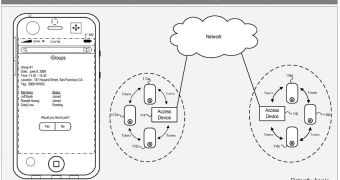A report by Patently Apple, the exclusive source tracking Apple's patent filings, reveals that the Mac maker is working on what it calls “Group Formation Using Anonymous Broadcast Information.” Put even simpler for those who know a thing or two about Apple, the company is developing an “iGroups” service.
The source reports that Apple is working on a new communications-based social networking application, called iGroups. The service would work on the iPhone, according to the documents published by the USPTO and picked up by Patently Apple, which deduces that “Apple's iGroup will be a new service that will work on your iPhone and likely work with MobileMe.” It explains that allowing groups of friends to attend events (such as a concert, a trade show, a business meeting etc), allowing them to share information and reactions to them as they're occurring is the focus of the service.
The patent provides example scenarios of both a concert and a WWDC event, to further shed light on how it would work. After outlining that iGroups marks Apple's fourth social networking application made public since the start of 2010, the site suggests that Apple is likely to make this happen, and soon too. Below is the actual abstract description of the invention, as found at the United States Patent & Trademark Office.
"A number of devices co-located at a geographic location can broadcast and receive tokens. Tokens can be exchanged using a communication link having limited communication range. Tokens that are received by a device can be stored locally on the device and/or transmitted to a trusted service operating remotely on a network. In some implementations, the tokens can be stored with corresponding timestamps to assist a trusted service in matching or otherwise correlating the tokens with other tokens provided by other devices. The trusted service can perform an analysis on the tokens and timestamps to identify devices that were co-located at the geographic location at or around a contact time which can be defined by the timestamps. A group can be created based on results of the analysis. Users can be identified as members of the group and invited to join the group."
Inventors credited for this invention are Daryl Low, Ronald Huang, Puneet Mishra, Gaurav Jain, Jason Gosnell and Jeff Bush, who consist of a new engineering team, according to the same report. The patent application was originally filed in 2008.

 14 DAY TRIAL //
14 DAY TRIAL //